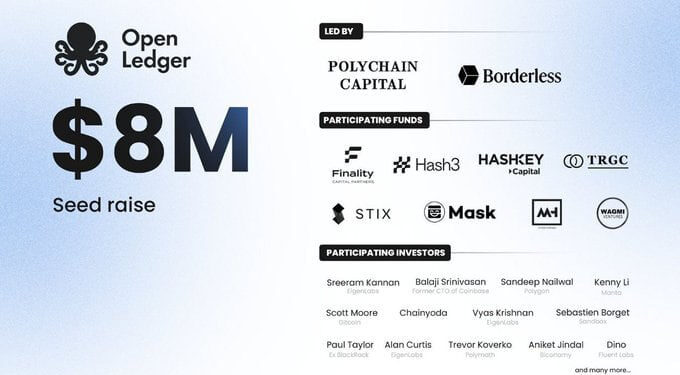Introduction
The Web3 revolution is transforming how we think about money, technology, and infrastructure. One of the fastest-growing movements inside this revolution is DePIN (Decentralized Physical Infrastructure Networks).
In simple terms, DePIN projects allow everyday people to contribute real-world resources—such as bandwidth, storage, or computing power—and get rewarded in return. Instead of giant corporations owning all the infrastructure, users share their devices and earn income.
Among the promising projects in this space is OpenLedger. The project has already raised $8 million USD in funding, led by Polychain Capital with support from ChainOpera AI and other investors. This strong financial backing signals that OpenLedger may become one of the leading names in DePIN.
This article is your complete beginner’s guide to OpenLedger. You will learn:
- What OpenLedger is and why it matters.
- How to set up the extension and nodes.
- How to earn through missions, referrals, and rewards.
- The advantages, risks, and comparisons with similar projects.
- Tips to maximize your earnings.
- Answers to the most common beginner questions.
If you are searching for an early opportunity in Web3, OpenLedger might be the right project to join now.
What Is OpenLedger?
OpenLedger is a decentralized infrastructure network. The goal is simple: reward users for contributing computing resources.
By installing the OpenLedger browser extension or running a node, you can earn points. Later, these points may convert into tokens once the project launches officially.
The vision of OpenLedger is powerful:
- Traditional model: Cloud and computing resources are owned by a few corporations.
- OpenLedger’s model: Anyone can participate, contribute, and benefit.
- Reward system: Users receive points based on their activity and contribution.
This approach creates a fairer digital economy. Instead of only tech giants controlling infrastructure, everyday users can monetize their devices and join the decentralized internet.
Why DePIN Matters in Web3
DePIN has become one of the most important sectors in Web3. The reason is clear: it connects blockchain with real-world utility.
In the past, most crypto projects focused only on tokens, speculation, and trading. DePIN changes the game by rewarding actual contributions.
Examples include:
- Helium – a decentralized wireless network.
- Filecoin – a decentralized storage system.
- Grass and DAWN – browser-based projects rewarding users for bandwidth and data.
These projects proved that DePIN can create value that goes beyond speculation. OpenLedger, backed by $8 million, is ready to join this growing list of pioneers.
How OpenLedger Works
OpenLedger allows you to participate in multiple ways:
- Browser Extension
- Install the OpenLedger extension.
- Keep it running to collect points while online.
- Node Installation
- Set up nodes on Windows, Linux, or Android.
- Nodes provide more resources and usually earn higher rewards.
- Missions & Rewards
- Complete daily tasks, check-ins, and missions.
- Earn bonus points on top of your extension or node rewards.
- Referral Program
- Invite friends using your referral code.
- Gain additional points when they join.
The process is user-friendly. You only need a Google account to log in and start.
Step-by-Step Guide to OpenLedger
Step 1: Sign Up
- Visit the official OpenLedger Testnet:
👉 https://testnet.openledger.xyz/?referral_code=dl2oxrz2em - Log in using your Google account.
Step 2: Install the Browser Extension
- Inside your dashboard, open the Store section.
- Download and install the OpenLedger Extension.
- Once activated, it runs in the background and earns points automatically.
Step 3: Install a Node (Optional but Recommended)
To boost your rewards:
- Install nodes on Windows, Linux, or Android.
- Running nodes allows deeper network participation.
- More resources = more points.
Step 4: Explore Missions & Rewards
- Go to the Missions & Rewards tab.
- Complete daily check-ins and bonus tasks.
- Tasks are quick and help you earn points faster.
- Get your unique referral code from the dashboard.
- Invite friends or community members.
- Earn extra points whenever they join with your code.
✔️ Done! You are now part of the OpenLedger ecosystem.
How Much Can You Earn?
Your earnings depend on several factors:
- How many hours your device stays online.
- Whether you only use the extension or also run nodes.
- How many missions you complete.
- How many referrals you bring in.
At this stage, you earn points, not tokens. These points are likely to convert into tokens after the Token Generation Event (TGE).
👉 Historically, early adopters of DePIN projects receive the biggest benefits. If you join now, you position yourself to earn more when tokens go live.
Advantages of OpenLedger
OpenLedger has several strengths:
- Strong funding – $8 million led by Polychain Capital.
- Multiple earning methods – extension, nodes, missions, and referrals.
- Easy onboarding – Google login makes it beginner-friendly.
- Cross-platform support – Windows, Linux, and Android.
- Community-driven growth – the referral system accelerates adoption.
Risks and Considerations
Like any Web3 project, OpenLedger also carries risks:
- Token uncertainty: Points only gain real value after TGE.
- Privacy: Only download extensions and nodes from official links.
- Market volatility: Token price may change rapidly post-launch.
- Execution risk: Success depends on adoption and continued development.
👉 Tip: Always diversify. Try multiple DePIN projects (Grass, DAWN, Stork, etc.) so you are not fully dependent on one platform.
OpenLedger vs Other DePIN Projects
How does OpenLedger compare to its competitors?
- Grass – Browser-based bandwidth sharing.
- DAWN – Raised $33M, also extension-based.
- Stork – Focused on computing validation, raised $4M.
- Helium & Filecoin – Hardware-heavy projects requiring special devices.
OpenLedger combines the simplicity of Grass with the backing and node support of larger projects like Filecoin. This hybrid approach makes it attractive to both beginners and advanced users.
Tips to Maximize Earnings
If you want to get the most from OpenLedger, follow these tips:
- Keep the browser extension active 24/7.
- Run nodes on multiple devices (Windows, Linux, Android).
- Complete missions daily for extra points.
- Share your referral code widely in online communities.
- Stay updated with announcements for bonus events.
Consistency is the key. Small actions daily can build large rewards over time.
Frequently Asked Questions (FAQ)
1. Is OpenLedger free to join?
Yes. You only need to install the extension. Running nodes is optional.
2. Can I use my smartphone?
Yes. OpenLedger supports Android nodes.
3. Do I need special hardware?
No. Regular computers and smartphones are enough.
4. How do I withdraw my rewards?
Currently, you collect points. They may convert to tokens after TGE.
5. Is OpenLedger safe?
Yes, but always download from official sources to avoid scams.
Why You Should Join OpenLedger Now
History shows that early adopters of DePIN projects often gain the highest returns. People who joined Helium, Filecoin, or Grass early earned far more than those who joined later.
Since OpenLedger is still in its testnet stage, this is the ideal time to join. You can accumulate points before the token launch and position yourself for future rewards.
Conclusion
OpenLedger is shaping up to be one of the most exciting DePIN projects of 2025. With $8 million in funding led by Polychain Capital and technical support from ChainOpera AI, it has strong foundations.
By simply installing the extension, running nodes, and completing missions, anyone can join. The points you earn today may become valuable tokens tomorrow.
👉 Don’t wait. Join the OpenLedger Testnet now and secure your spot as an early adopter.
With minimal effort, you can be part of the next wave of decentralized infrastructure—and potentially enjoy big rewards when OpenLedger launches officially.



![Browser Cash [Depin/Node]: Earn Passive Rewards Easily](https://sinhmmo.com/wp-content/uploads/2025/09/Browser-Cash-Depin-Node-350x250.jpg)
